Elementary Embroidery by Mary Symonds is a little gem of a book – it’s old, it’s thorough on the basics, it’s still applicable today, and – perhaps best of all – it’s free!
I like to go squizzing around online to see what out-of-print needlework books are available. I really think that you can find just about any “how to” information on needlework online, in the old books, catalogs, and pamphlets printed before 1950 and made available on various websites for free. Sure, the instructions rely more on words than photos, and sure, the books are mostly black and white with line drawings (at best) for instruction, and sure, needlework products have changed a lot in the last 75 years. But the technique is there, and the technique is generally very good! If nothing else, many of the books are fun to read just to see how things used to be done!
This particular book – Elementary Embroidery – has some elements in it that I really like. If you have time, you might want to take a look at it.
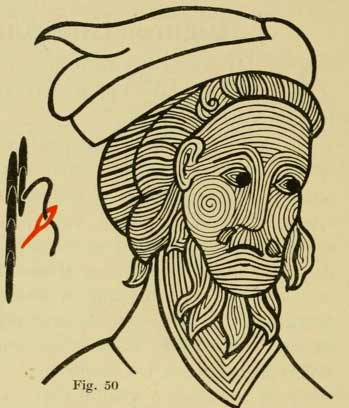
First off, there’s a nice intro on materials for embroidery. Though the book was printed in 1915, much of the information here is still very applicable.
The materials used are many and various. Most linens, if firm and of tolerably good quality, are good for working upon, but if drawn-thread is to be required, care should be taken to see that the warp and weft threads are of the same thickness and evenly woven… Silks should be uniformly woven and of sufficient close texture to take the stitching properly; satins with a linen warp are quite successful for furniture and heavy use as they wear better than most pure silks… Cloth-of-gold and materials woven with metals are very difficult to embroider upon, except in metal, and it usual when silk embroidery is required, to execute the same on linen and then transfer it to the background by couching or some similar method.
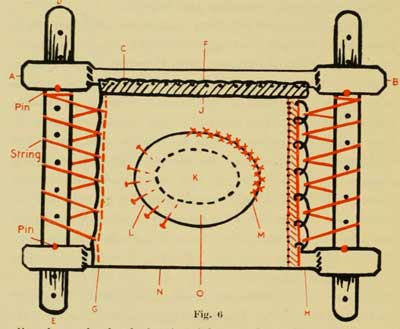
The book is peppered with black and red line drawings that demonstrate various methods of doing things embroidery-related. Above, for example, is a diagram of how fabric is mounted on the slate frame, which the author refers to as an “ordinary frame.” She goes into clear and precise detail on the mounting of work on the slate frame.
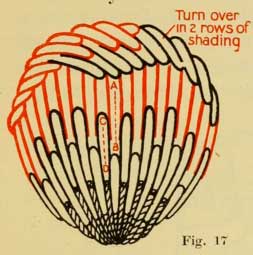
The stitching directions throughout the book are also given in diagram form. While there are no step-by-step photos, the diagram and the text together instruct thoroughly on the technique being discussed. She even includes handy little tips:
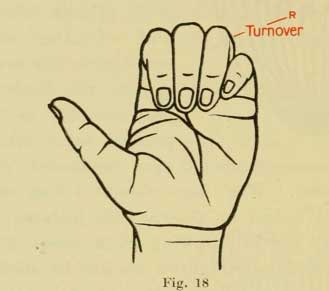
Great car is needed in working what is called a “turn-over,” in either a leaf or a flower; the direction of the stitches in the turnover should be such that if the latter were turned back, these stitches would follow on in the same direction as those of the rest of the leaf or petal. A good illustration of this is obtained by holding up the hand, palm foremost, forming, as it were, a leaf or petal, then bending the fingers forward to form the turnover – the fingers will indicate the direction of the embroidery stitches.
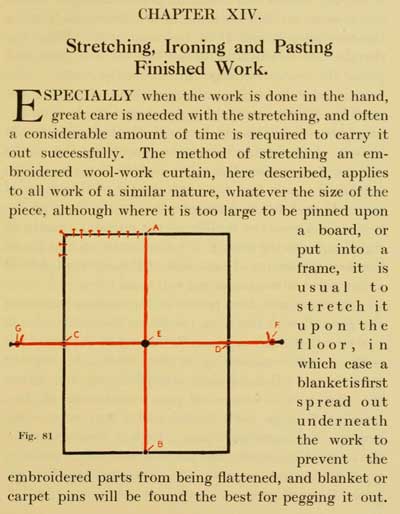
Perhaps one of the most informative sections to read is the last part of the book, on finishing. While I don’t necessarily “paste” too much of my work, it is good to read about these blocking and finishing techniques that can still be used to good effect.
The book Elementary Embroidery by Mary Symonds can be found on the Internet Archives, which is a terrific source for out-of-print books in digital format. If you click the “read online” link on the left, underneath the image of the book, you’ll get an easy-page-turning view of the book, which you can flip through at your leisure.
I hope you enjoy taking a look at this old book on the basics of embroidery! For other free online needlework books, check out my Books & Links page. After the section on book reviews, you’ll find a list of online books I particularly like.







Through the years I have collected “old” sewing and embroidery books. I actually have 2 copies of this on my shelf and refer to it often. As with most “old” embroidery books, you have to read the text carefully to extract all the gems they have to offer. Often I find they contain extremely practical tips and answer questions you haven’t though of yet! Nice to hear it is online.
Thankyou for this book.
Love the chapters on solid shading and goldwork – some nice explanations there.
Any ideas on how to extract those pages from one of the formats of the documents so I can put them in my Word notes? (since it isn’t copyright)
That would be of great help. 🙂
Thanks, Mary, for this very interesting book. I will download and read it soon. What a gem!
I love old needlework books. Thank you so much for sharing this website and the book.
excellent find, thank u!
Hi Mary,
I have been reading your blogs (and the reader comments) for several weeks and find them very informative. Have you ever thought of combining your love of English and embroidery and writing a sewing-themed romance novel (a high-quality one)? In this week’s issue of Bloomberg Business Week, they talk about the micro-genres of quilting and knitting romance novels and describe that the proffitable authors have 6,000+ social networking “friends”- you have more than that on this website I’m sure. This sector of publishing is growing- unlike almost all other print media, and is highly proffitable because readers are sticking to the comforts and frugality of home-based entertainment. Just a thought.
P.S. I am a molecular biologist- so I have no agenda to push.
Hi, Irene – Thanks for your note. Oh, golly. To tell you the truth, the thought has never, ever occurred to me. I could see the opener: “It was a mutual attraction to silk that brought them together….” It’s not a type of writing I’ve ever attempted. I could see writing a mystery long before I could see writing a “romance” (in the pit-pat-pitter-pat sense). Something along the lines of Clue: it was Mrs. Ackworth in the Studio with the Laying Tool! Ahem. Well. I may not be the type for it! But it’s fun to think about! If it ever happens, I’ll let you know! ~MC
Hi Elmsley Rose — One of the neat things about the documents at the Internet Archive is that they’re not simple scans of the books. The .pdf files are searchable for individual words or phrases and the text can be highlighted, copied, and pasted into a number of word processing formats, including Word. Simply open the file in Acrobat Reader, use the “Select Text” tool, copy the text selected, then paste. I recommend using “Paste Special” to paste it into Word as unformatted text, because there can be some peculiarities in the typefaces that will pop up. You should also be prepared for the margins to be set to have exactly the number of words that are on an individual line in the book (in this case, when I tried it, I got about a 4″ wide column of text instead of my normal defaults for 8-1/2 x 11″ paper) because there are hard returns at the end of each line instead of at the end of each paragraph.
Hope this helps!
G’day Mary,
Certainly an interesting and diverse world was shut to me when I didn’t have the computer.
I mostly go into other sites from your’s. Like this book/archives/library one. And if it’s someone’s shop/gallery sort of thing I end up going here there and everywhere, wandering from one look-it-up to the next, and seeing so much of interst that I didn’t know existed. Just in the needlework/art/book worlds mostly. I Googled Mark Murphy (made the miniature casket), when got to looking at your posts that I missed, and was amazed at the minitures other people made too. A miniature doll house 1:12(the inside items are 1:144). Gotta watch the time tho. Time flies when your feasting on articles that are to your taste.
So thank you for this beaut book site and this book in particular. The illustrations are very clear and easy to understand along with the text. I’m very pleased. Love old things too.
Cheers then Mary, Kath
Thank you very much for the link. It is a very interesting book.
Thanks Mary for the link. It is an interesting book.
Mary
Thank you for the link. What a find….
Fredi
Thankyou so much, Karen from Arcadia!!
This is a very late follow-up but I have been really excited by this book.
I was reading the book and decided to look up the references to items held in the Victoria and Albert museum which is in the List of Exhibits … on page 172.
The Victoria and Albert website is extremely badly designed but once you get to collections (http://collections.vam.ac.uk) and choose “more search options” and fill in the museum object number from the List of Exhibits you can see some really interesting results. Not all of them have images and many of the items are in storage.
There doesn’t seem a good way to browse for embroidery – I wasted a lot of time before having to resort to putting in individual item numbers.
Another example is that Muslim Embroidery Chapter VII has only 2 diagrams in the text but there are 17 references in the List of Exhibits.
There is obviously so much information in the List – I hope to get more time to explore.
The Books Useful for Reference is also very good. A number of them are available on-line and have been reviewed by Mary.